Module 11 Way of life Unit 3 Grammar 课件 (共22张PPT,含内嵌音频) 2024-2025学年英语外研版八年级上册
文档属性
| 名称 | Module 11 Way of life Unit 3 Grammar 课件 (共22张PPT,含内嵌音频) 2024-2025学年英语外研版八年级上册 | 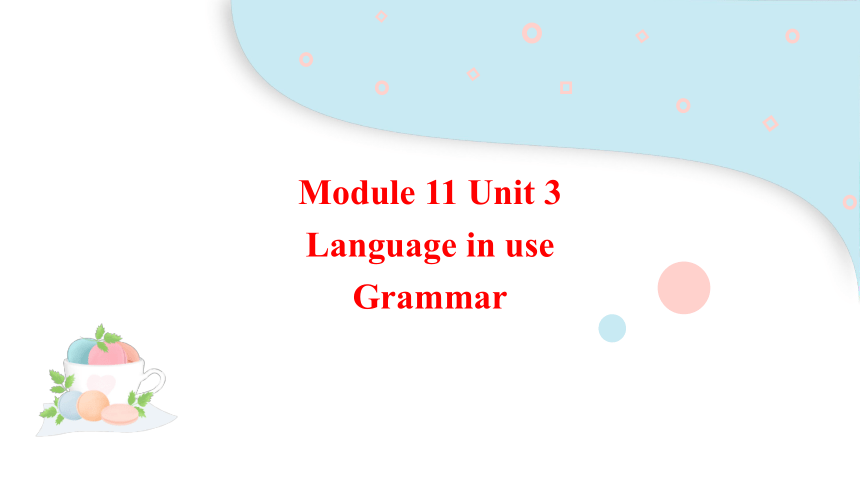 | |
| 格式 | pptx | ||
| 文件大小 | 1.3MB | ||
| 资源类型 | 教案 | ||
| 版本资源 | 外研版 | ||
| 科目 | 英语 | ||
| 更新时间 | 2024-07-20 10:12:10 | ||
图片预览



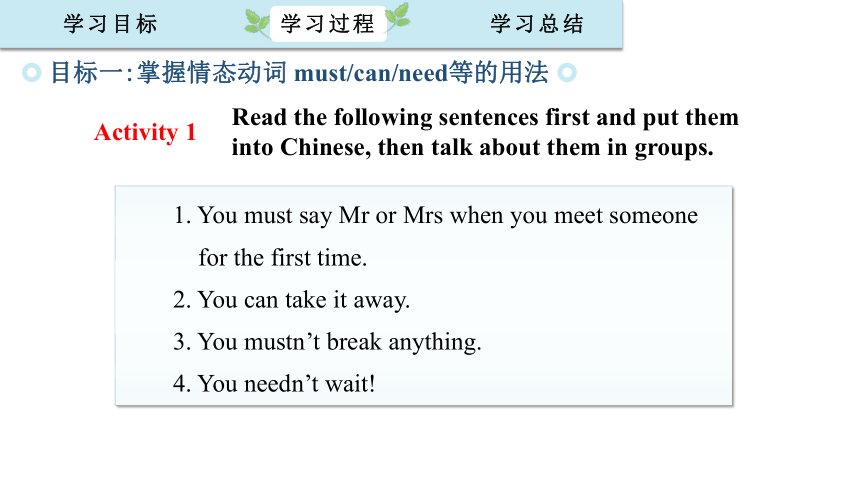
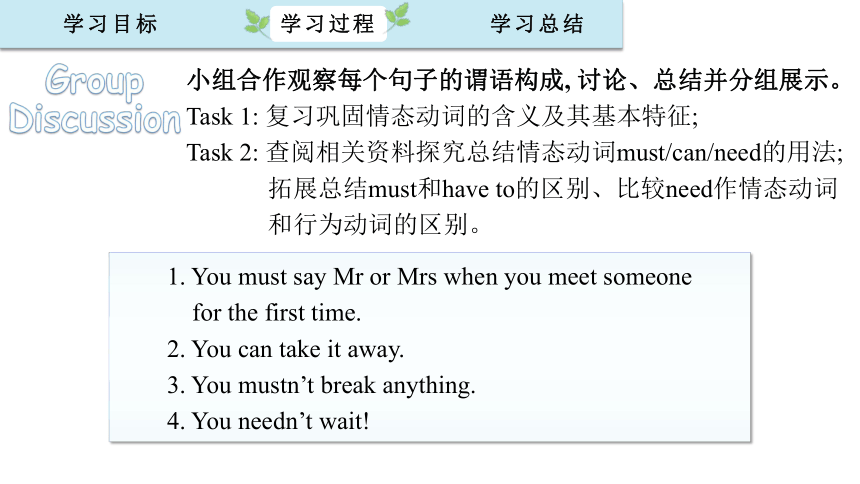
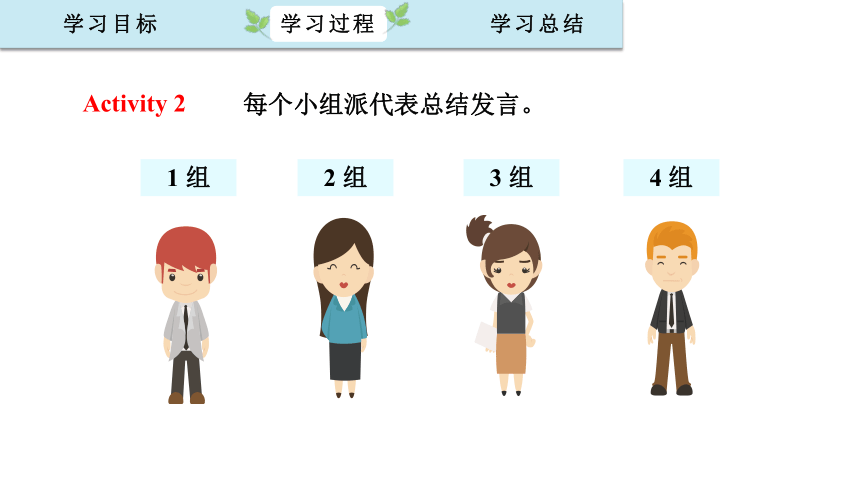

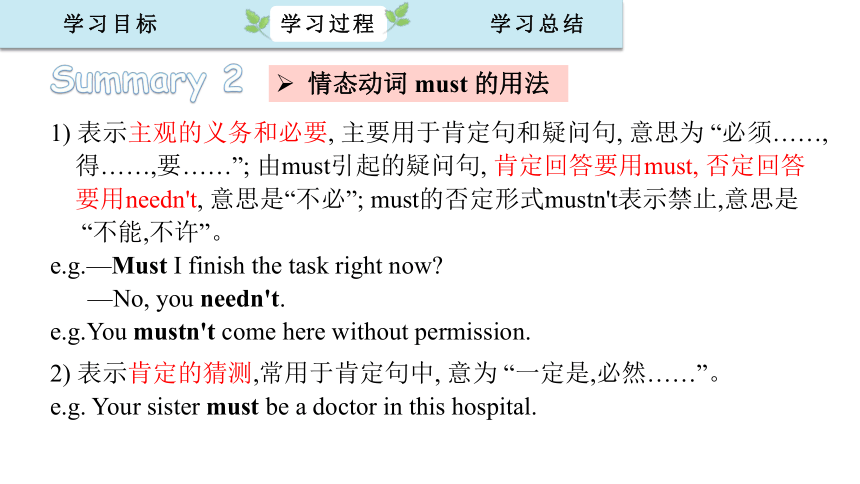
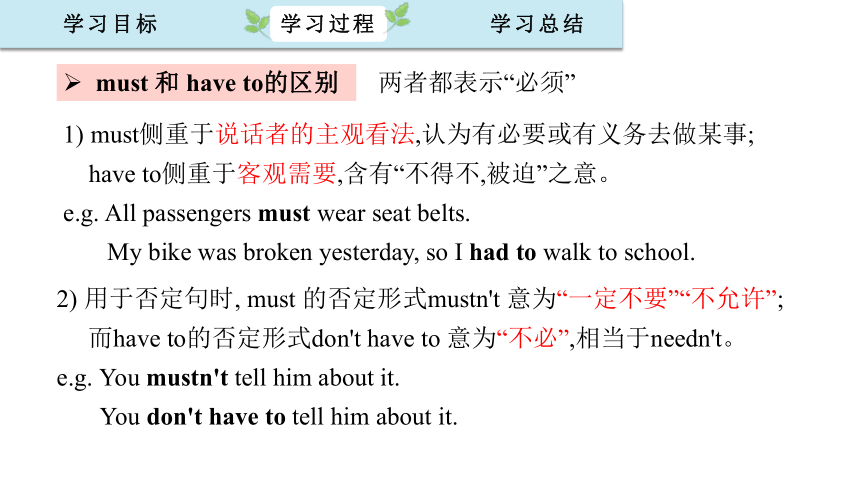
文档简介
(共22张PPT)
Module 11 Unit 3
Language in use
Grammar
Look at the pictures and make sentences
with modal verbs:
You can’t/mustn’t
smoke.
You must stop
at a red light.
You can/should go at a green light.
He need/should wear warm clothes.
Free Talk
must/can/need
1
2
能掌握情态动词must/can/need等的用法。
能正确运用must/can/need等谈论规则或习俗。
目标一:掌握情态动词 must/can/need等的用法
Activity 1
Read the following sentences first and put them
into Chinese, then talk about them in groups.
1. You must say Mr or Mrs when you meet someone
for the first time.
2. You can take it away.
3. You mustn’t break anything.
4. You needn’t wait!
Group
Discussion
小组合作观察每个句子的谓语构成, 讨论、总结并分组展示。
Task 1: 复习巩固情态动词的含义及其基本特征;
Task 2: 查阅相关资料探究总结情态动词must/can/need的用法;
拓展总结must和have to的区别、比较need作情态动词
和行为动词的区别。
1. You must say Mr or Mrs when you meet someone
for the first time.
2. You can take it away.
3. You mustn’t break anything.
4. You needn’t wait!
Activity 2
每个小组派代表总结发言。
1 组
2 组
3 组
4 组
Activity 3
Summary 1
情态动词
1.含 义
情态动词是一种本身有一定的词义,表示说话人的情绪,态度或语气的
动词,但不能单独作谓语,只能和其他动词原形构成谓语。
2.基本特征
情态动词+ 动词原形;
情态动词无人称和数的变化;
否定式构成是在情态动词后面加 "not";
Summary 2
情态动词 must 的用法
2) 表示肯定的猜测,常用于肯定句中, 意为 “一定是,必然……”。
e.g. Your sister must be a doctor in this hospital.
1) 表示主观的义务和必要, 主要用于肯定句和疑问句, 意思为 “必须……,
得……,要……”; 由must引起的疑问句, 肯定回答要用must, 否定回答
要用needn't, 意思是“不必”; must的否定形式mustn't表示禁止,意思是
“不能,不许”。
e.g.—Must I finish the task right now
—No, you needn't.
e.g.You mustn't come here without permission.
must 和 have to的区别
1) must侧重于说话者的主观看法,认为有必要或有义务去做某事;
have to侧重于客观需要,含有“不得不,被迫”之意。
e.g. All passengers must wear seat belts.
My bike was broken yesterday, so I had to walk to school.
2) 用于否定句时, must 的否定形式mustn't 意为“一定不要”“不允许”;
而have to的否定形式don't have to 意为“不必”,相当于needn't。
e.g. You mustn't tell him about it.
You don't have to tell him about it.
两者都表示“必须”
情态动词 can 的用法
1) 表示能力
e.g. I can't swim. 我不会游泳。
【注意】can表示能力可与be able to互换使用,且后者有更多的时态,
be able to常被用来表示can所不能表示的将来或完成的概念。
e.g. They will be able to run this machine on their own in three months.
2) 表示可能性, 意思是“可以,可能”。
e.g. He can be very friendly at times.
3) 表示允诺,意思是“可以,能够”。
e.g. You can have the book when I have finished it.
4) 表示惊异、不相信、猜测等(用于疑问句、否定句或感叹句中),
意思是“会,可能”。
e.g. This can't be true. / Can it be true
can的否定形式为cannot, 缩写为can't。
情态动词 need 的用法及区别
1. 作情态动词
(1) need作情态动词时无人称或数的变化,后接动词原形。
e.g. You needn't worry.
(2) 由need引出的一般疑问句, 肯定回答常用must或have to;
否定回答常用 needn't。
e.g. —Need I answer the question
—Yes, you must/have to. / No, you needn't.
need意为 “需要”
2. 作行为动词
need 作行为动词时, 有人称和数的变化, 后面可接名词、代词、或
动词不定式; 常用于 need to do sth. 结构, 表示“需要干…”可用于
肯定句、疑问句和否定句中。
e.g. She needs help.她需要帮助。
I don't need to see the doctor.
—Do you need to go at once
—Yes, I do. /No, I don't.
拓展
had better
1) had better表示劝告或建议, 意思是 “最好.....”
e.g. You'd better get some sleep. 你最好睡一会儿。
2) had better一般不用于疑问句中, 但可用于否定句中,
其否定形式为had better not。
e.g. You'd better not waste any more of your time.
你最好别再浪费你的时间了。
目标二:正确运用 must/can/need 等谈论规则或习俗
Activity 1
1
Complete the conversations with can or can’t.
1. A: Can you drive a car at the age of seventeen in England
B: Yes, we _____ How about in China
A: No. we______.
2. A: Can you open a gift immediately after you receive it in England
B:__________ .What about in China
A: No, we usually don’t
3. A: Can you push your way onto a bus in England
B:___________. How about in China
A: No. we _____either.
4. A: Can you drive on the right-hand side of the road in England
B:____________.What about in China A: Yes, we must.
can
can’t
Yes, we can
No, we can’t
can’t
No, we can’t
Underline the correct words.
It is important to know what you must and must not do when you meet people from a different country.
You (1) may / must not ask Westerners “How old are you ” because it is not polite. You (2) might / can know someone well, but (3) you must / need not ask “How much money do you make ” He (4) may / can never speak to you again!
In public places, you (5) must / can ask people before you take photos of them, and you (6) must not / might not eat or drink in shops or museums.
In some countries you (7) cannot / can go into someone’s house with your shoes on. You (8) need not / must not take them off. But in some other countries you (9) might / must not wear shoes in the house.
3
Try to make a face book about cultures of English-speaking countries. Write down the interesting things you find.
Look for some pictures to go with them.
Learning to learn
2
Complete the sentences with must or must not.
School rules
1 You be late for school.
2 You eat in the library.
3 You ride your bike in
the playground.
4 You do your homework.
5 You listen to the teacher.
must not
must not
must not
must
must
4
Listen to a teenager talking about his life. Check (√) the things he must or mustn't do.
must mustn’t
1 clean up bedroom once a week
2 wash up after dinner
3 stay out after 9 pm
4 do homework before going out
5 wash hands before dinner
6 play music loudly after 10 pm
√
√
√
√
√
√
Activity 2
5
Listen again. What two things does he say he can do
1 ___________________________________________
2 ___________________________________________
He can go out with his friends at weekends.
He can play music before ten o’clock at night.
Listen again and check your answers.
Well, my parents are quite strict. I must clean up my bedroom once a week and I must always wash up after dinner. My parents are very strict about that.
I mustn’t stay out after nine o’clock at night, but I can go out with my friends at weekends. I must do my homework before I go out and I must wash my hands before dinner. I can play music, but I mustn’t
play it loudly after ten o’clock at night.
6
Activity 3
Write some things you can, must and must not do at home.
I can… I must… I must not…
Now work in pairs. Tell each other three things you must do
at home and three things you mustn’t do. Are your home rules different or the same
— I must visit my grandparents once a week.
I mustn’t stay up late in the evening.
— ...
综合上述目标,说说我们今天的收获。
学习目标
1
2
能掌握情态动词must/can/need等的用法。
能正确运用must/can/need等谈论规则或习俗。
Module 11 Unit 3
Language in use
Grammar
Look at the pictures and make sentences
with modal verbs:
You can’t/mustn’t
smoke.
You must stop
at a red light.
You can/should go at a green light.
He need/should wear warm clothes.
Free Talk
must/can/need
1
2
能掌握情态动词must/can/need等的用法。
能正确运用must/can/need等谈论规则或习俗。
目标一:掌握情态动词 must/can/need等的用法
Activity 1
Read the following sentences first and put them
into Chinese, then talk about them in groups.
1. You must say Mr or Mrs when you meet someone
for the first time.
2. You can take it away.
3. You mustn’t break anything.
4. You needn’t wait!
Group
Discussion
小组合作观察每个句子的谓语构成, 讨论、总结并分组展示。
Task 1: 复习巩固情态动词的含义及其基本特征;
Task 2: 查阅相关资料探究总结情态动词must/can/need的用法;
拓展总结must和have to的区别、比较need作情态动词
和行为动词的区别。
1. You must say Mr or Mrs when you meet someone
for the first time.
2. You can take it away.
3. You mustn’t break anything.
4. You needn’t wait!
Activity 2
每个小组派代表总结发言。
1 组
2 组
3 组
4 组
Activity 3
Summary 1
情态动词
1.含 义
情态动词是一种本身有一定的词义,表示说话人的情绪,态度或语气的
动词,但不能单独作谓语,只能和其他动词原形构成谓语。
2.基本特征
情态动词+ 动词原形;
情态动词无人称和数的变化;
否定式构成是在情态动词后面加 "not";
Summary 2
情态动词 must 的用法
2) 表示肯定的猜测,常用于肯定句中, 意为 “一定是,必然……”。
e.g. Your sister must be a doctor in this hospital.
1) 表示主观的义务和必要, 主要用于肯定句和疑问句, 意思为 “必须……,
得……,要……”; 由must引起的疑问句, 肯定回答要用must, 否定回答
要用needn't, 意思是“不必”; must的否定形式mustn't表示禁止,意思是
“不能,不许”。
e.g.—Must I finish the task right now
—No, you needn't.
e.g.You mustn't come here without permission.
must 和 have to的区别
1) must侧重于说话者的主观看法,认为有必要或有义务去做某事;
have to侧重于客观需要,含有“不得不,被迫”之意。
e.g. All passengers must wear seat belts.
My bike was broken yesterday, so I had to walk to school.
2) 用于否定句时, must 的否定形式mustn't 意为“一定不要”“不允许”;
而have to的否定形式don't have to 意为“不必”,相当于needn't。
e.g. You mustn't tell him about it.
You don't have to tell him about it.
两者都表示“必须”
情态动词 can 的用法
1) 表示能力
e.g. I can't swim. 我不会游泳。
【注意】can表示能力可与be able to互换使用,且后者有更多的时态,
be able to常被用来表示can所不能表示的将来或完成的概念。
e.g. They will be able to run this machine on their own in three months.
2) 表示可能性, 意思是“可以,可能”。
e.g. He can be very friendly at times.
3) 表示允诺,意思是“可以,能够”。
e.g. You can have the book when I have finished it.
4) 表示惊异、不相信、猜测等(用于疑问句、否定句或感叹句中),
意思是“会,可能”。
e.g. This can't be true. / Can it be true
can的否定形式为cannot, 缩写为can't。
情态动词 need 的用法及区别
1. 作情态动词
(1) need作情态动词时无人称或数的变化,后接动词原形。
e.g. You needn't worry.
(2) 由need引出的一般疑问句, 肯定回答常用must或have to;
否定回答常用 needn't。
e.g. —Need I answer the question
—Yes, you must/have to. / No, you needn't.
need意为 “需要”
2. 作行为动词
need 作行为动词时, 有人称和数的变化, 后面可接名词、代词、或
动词不定式; 常用于 need to do sth. 结构, 表示“需要干…”可用于
肯定句、疑问句和否定句中。
e.g. She needs help.她需要帮助。
I don't need to see the doctor.
—Do you need to go at once
—Yes, I do. /No, I don't.
拓展
had better
1) had better表示劝告或建议, 意思是 “最好.....”
e.g. You'd better get some sleep. 你最好睡一会儿。
2) had better一般不用于疑问句中, 但可用于否定句中,
其否定形式为had better not。
e.g. You'd better not waste any more of your time.
你最好别再浪费你的时间了。
目标二:正确运用 must/can/need 等谈论规则或习俗
Activity 1
1
Complete the conversations with can or can’t.
1. A: Can you drive a car at the age of seventeen in England
B: Yes, we _____ How about in China
A: No. we______.
2. A: Can you open a gift immediately after you receive it in England
B:__________ .What about in China
A: No, we usually don’t
3. A: Can you push your way onto a bus in England
B:___________. How about in China
A: No. we _____either.
4. A: Can you drive on the right-hand side of the road in England
B:____________.What about in China A: Yes, we must.
can
can’t
Yes, we can
No, we can’t
can’t
No, we can’t
Underline the correct words.
It is important to know what you must and must not do when you meet people from a different country.
You (1) may / must not ask Westerners “How old are you ” because it is not polite. You (2) might / can know someone well, but (3) you must / need not ask “How much money do you make ” He (4) may / can never speak to you again!
In public places, you (5) must / can ask people before you take photos of them, and you (6) must not / might not eat or drink in shops or museums.
In some countries you (7) cannot / can go into someone’s house with your shoes on. You (8) need not / must not take them off. But in some other countries you (9) might / must not wear shoes in the house.
3
Try to make a face book about cultures of English-speaking countries. Write down the interesting things you find.
Look for some pictures to go with them.
Learning to learn
2
Complete the sentences with must or must not.
School rules
1 You be late for school.
2 You eat in the library.
3 You ride your bike in
the playground.
4 You do your homework.
5 You listen to the teacher.
must not
must not
must not
must
must
4
Listen to a teenager talking about his life. Check (√) the things he must or mustn't do.
must mustn’t
1 clean up bedroom once a week
2 wash up after dinner
3 stay out after 9 pm
4 do homework before going out
5 wash hands before dinner
6 play music loudly after 10 pm
√
√
√
√
√
√
Activity 2
5
Listen again. What two things does he say he can do
1 ___________________________________________
2 ___________________________________________
He can go out with his friends at weekends.
He can play music before ten o’clock at night.
Listen again and check your answers.
Well, my parents are quite strict. I must clean up my bedroom once a week and I must always wash up after dinner. My parents are very strict about that.
I mustn’t stay out after nine o’clock at night, but I can go out with my friends at weekends. I must do my homework before I go out and I must wash my hands before dinner. I can play music, but I mustn’t
play it loudly after ten o’clock at night.
6
Activity 3
Write some things you can, must and must not do at home.
I can… I must… I must not…
Now work in pairs. Tell each other three things you must do
at home and three things you mustn’t do. Are your home rules different or the same
— I must visit my grandparents once a week.
I mustn’t stay up late in the evening.
— ...
综合上述目标,说说我们今天的收获。
学习目标
1
2
能掌握情态动词must/can/need等的用法。
能正确运用must/can/need等谈论规则或习俗。
同课章节目录
- Module 1 How to learn English
- Unit 1 Let's try to speak English as much as possi
- Unit 2 You should smile at her.
- Unit 3 Language in use .
- Module 2 My home town and my country
- Unit 1 It's taller than many other buildings.
- Unit 2 Cambridge is a beautiful city in the east o
- Unit 3 Language in use .
- Module 3 Sports.
- Unit 1 Nothing is more exciting than playing tenni
- Unit 2 This year we training more carefully.
- Unit 3 Language in use .
- Module 4 Planes, ships and trains .
- Unit 1 He lives the farthest from school.
- Unit 2 What is the best way to travel.
- Unit 3 Language in use .
- Module 5 Lao She Teahouse.
- Unit 1 I wanted to see the Beijing Opera.
- Unit 2 It descibes the changes in Chinese society.
- Unit 3 Language in use .
- Module 6 Animals in danger.
- Unit 1 It allows people to get closer to them .
- Unit 2 The WWF is working hard to save them all.
- Unit 3 Language in use .
- Revision module A
- Module 7 A famous story
- Unit 1 Alice was sitting with her sister by the ri
- Unit 2 She was thinking about her cat.
- Unit 3 Language in use .
- Module 8 Accidents
- Unit 1 While the car were changing to red, a car s
- Unit 2 I was trying to pick it up when it bite me
- Unit 3 Language in use .
- Module 9 Population
- Unit 1 The population of China is about 1.37 billi
- Unit 2 Arnwick was a city with 200,000 people.
- Unit 3 Language in use .
- Module 10 The weathe
- Unit 1 It might snow.
- Unit 2 The weather is fine all year round.
- Unit 3 Language in use .
- Module 11 Way of life
- Unit 1 In China ,we open a gift later.
- Unit 2 In England, you usually drink tea with milk
- Unit 3 Language in use .
- Module 12 Help
- Unit 1 What should we do before help arrives?
- Unit 2 Stay away from windows and heavy furniture.
- Unit 3 Language in use .
- Revision module B
